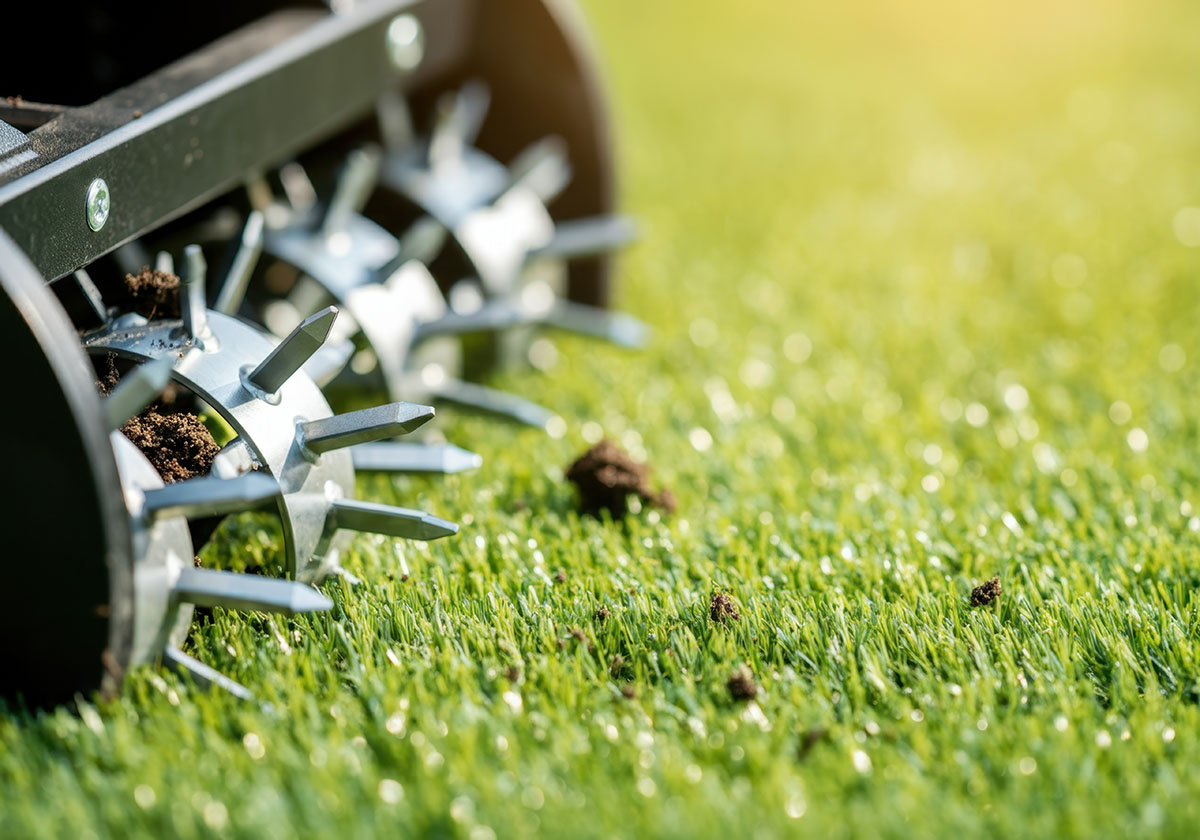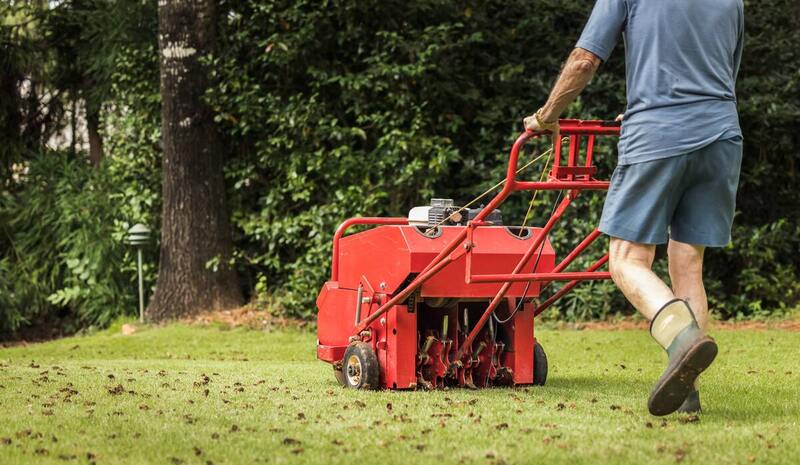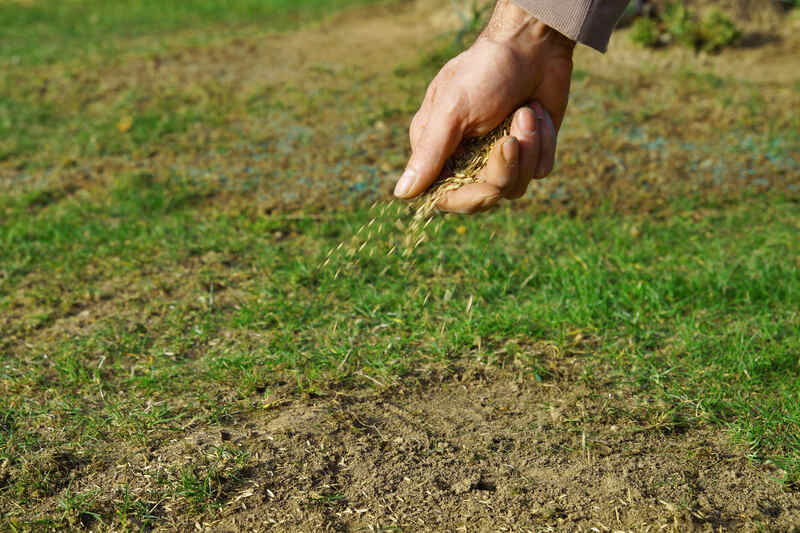
The best time to aerate and overseed is right after your grass wakes up from dormancy until mid-growing season. The trick is, it varies by type of grass and where you live.
Cool-season grasses thrive in the northern regions and are best overseeded in late summer to early fall. Southern warm-season varieties perform best when seeded in late spring to early summer.
What if you live in the transition zone? Both grass types grow well in the central U.S. Just match your overseeding time to your grass variety.
Quick terminology tip: “Overseeding” is commonly used for spreading grass seed on an existing lawn for thickness or winter color, and that is how we use it in this article. But technically, there are two different terms for this lawn treatment:
- “Overseeding”: Seeding with a different type of grass (e.g., Bermuda with rye)
- “Interseeding”: Seeding with the same type or mix of grasses
Cool-Season vs. Warm-Season Grasses

Cool-season grasses thrive in the Northern U.S., growing best in spring and fall while often dormant in summer. Their bunch-growth type prevents self-repair, making overseeding essential for a dense, weed-resistant lawn.
Overseed when soil temperatures range between 50 F to 65 F during active growth periods — ideally late summer to early fall, or early spring if necessary.
The most popular cool-season grasses are:
- Fine fescues
- Kentucky bluegrass (KBG)
- Perennial ryegrass
- Tall fescue

Warm-season grasses flourish in the Southern U.S., growing actively from late spring through early fall before winter dormancy. They spread through runners and often fill in thin spots naturally, so let the lawn fully green up before overseeding; you might need less seed than you think.
For best results, plant the seed when soil temperatures are 65 F to 75 F, typically late spring to early summer.
Most common warm-season grasses:
- Bahia
- Bermudagrass
- Buffalograss
- Centipede
- St. Augustine
- Zoysia
See Related: When is the Best Time to Plant Grass Seed?
Best Time for Cool-Season Grass Area

If you live in the northern half of the country and your lawn has tall fescue, fine fescues, perennial ryegrass, or Kentucky bluegrass, aerate and overseed:
- Mid-August to mid-September (primary window)
- May to mid-June (secondary window)
New seedlings struggle with northern winters. Overseed when soil temperatures fall below 65 F, but allow at least 45 days before the first hard frost. For spring overseeding, wait until after the last frost date.
First time overseeding? Read our guides:
- How to Prepare Your Lawn for Aeration and Overseeding
- How to Aerate a Lawn
- How to Overseed a Lawn in 8 Simple Steps
| Or, let LawnStarter aeration pros do the work for you — our pros aerated and overseeded 245 lawns last year with a 4.1-star rating and an average cost of $302 for lawns under ¼ acre. |
Two Exceptions Worth Noting
- Dormant overseeding: Plant in late fall to early winter when the soil is cold (45 F to 50 F) but not frozen. Seeds sleep through winter and sprout in spring.
- Frost overseeding: Done in late winter to early spring during freeze-thaw cycles. The freezing and thawing work seeds into the soil naturally.
Dormant seeding and frost seeding work best in areas with consistent snow cover and cold winters. In warmer regions, temperature spikes can trigger early germination, exposing seedlings to freezes.
See Related:
Best Time for Transition Zone
The transition zone spans across the central U.S., where both types of grass can grow. Your overseeding schedule depends on the type of grass on your lawn.
For Cool-Season Grasses
Homeowners living in the transition zone and growing a cool-season variety (KBG, ryegrass, or tall fescue) can aerate and overseed:
- Late-August to mid-October (primary window)
- March to April (secondary window)
Summer arrives earlier and is hotter than in the north. If you overseed in the spring, provide enough water to protect new seedlings from heat and drought.
For Warm-Season Grasses
For transition zone lawns growing warm-season grasses like Bermudagrass or Zoysia (the most cold-tolerant species), the best time to aerate and overseed is May to June.
The magic happens when your grass exits winter dormancy but hasn’t yet reached peak summer growth. Once the soil temperature climbs over 65 F, you’re in business.
Why this timing is ideal for warm-season grasses:
- Your lawn gets maximum health benefits from aeration
- Rising temperatures boost germination and grass growth
- No more frost surprises
- Seedlings have at least 3 full months to toughen up before cool weather and dormancy
For Overseeding Bermuda with Rye

Want a green Bermuda lawn all winter? In the transition zone, seed ryegrass over your lawn in mid-September through October.
Timing is crucial. You need daytime air temperatures between 80 F and 85 F and nighttime lows at about 55 F, and at least 30 days before the first frost.
Overseed too early, and Bermuda overwhelms the cool-season grass. Too late, and frost kills the rye seedlings. Fall is a busy season, so many homeowners decide to hire a landscaping pro to get the seed planted on time.
See Related: Guide to Growing Grass in the Transition Zone
Best Time for Warm-Season Grass Area
For Warm-Season Grasses
Folks living in the southern half of the country and growing warm-season grasses (Bermudagrass, Zoysia, St. Augustine, bahia, buffalograss, or centipede) should aerate and overseed from April to July when soil temperatures go over 65 F.
For Overseeding Bermuda with Rye
Overseed your southern Bermuda lawn with ryegrass in late September through mid-November.
The South cools down slower, so you’ll seed rye later than homeowners in the transition area. Wait for temperatures to drop to 55 F during the night.
Why is Fall Better Than Spring for Cool-Season Grasses?
Experts recommend seeding cool-season lawns between late summer and early fall, with spring as a secondary option. Here’s why:
| Late Summer to Early Fall Conditions | Early Spring Conditions |
| • Your lawn has its longest growing period ahead • Cooling temperatures trigger deep root growth (exactly what baby grass needs) • Frequent rain and morning dew keep seeds moist • Mild days and cool nights prevent heat stress • Summer weeds are dying back, giving new grass room to breathe | • Crabgrass season means more weed competition • You can’t use herbicides without harming new grass • A surprise late frost could kill seedlings • Summer heat arrives fast, stressing young plants and demanding more irrigation |
If you want a tough, drought-resilient lawn next summer, fall is the best time to seed your lawn. Fall lawn treatments also help prepare the lawn for winter stress.
Don’t cross out spring altogether — it’s a good time to repair winter damage, such as bare patches caused by snow mold.
When It’s Too Late to Aerate and Overseed
Missing these ideal windows is a costly aeration and overseeding mistake. Here’s when to postpone for the next season to cut your losses.
Cool-season grasses
- Fall: Less than 45 days before the first frost or soil under 50 F
- Spring: Soil over 65 F
Warm-season grasses:
- Less than 90 days before the first frost and air temperatures over 90 F
Bermuda overseeding:
- Less than 30 days before the first frost or nights under 50 F
FAQ
Signs that indicate you need to overseed your lawn include thin, blunt grass that grows slowly even during peak season and gets invaded by bare patches and weeds.
Once a year works for most lawns, but high-traffic areas and lawns with clay soil that is easily compacted may benefit from twice-yearly aeration and overseeding.
You can overseed right after aerating the soil. The aeration holes create perfect seed-to-soil contact, resulting in superior germination rates.
Homeowners across the United States pay an average of $107 to $202 for professional lawn aeration, with prices varying based on lawn size, aeration type, and location.
Hire a Pro to Aerate and Overseed at the Right Time
Timing is everything, but you don’t have to figure it out alone. LawnStarter’s landscaping pros know exactly when to aerate and overseed in your neighborhood. Skip the guesswork — get your free quote today and let our landscaping experts give you that thick, healthy lawn you’ve been wanting.
Need the lawn mowed before your aeration and overseeding service? Let LawnStarter’s lawn care pros get your lawn trim and ready.
Sources:
- “Lawn Renovation & Overseeding.” University of Massachusetts Amherst.
- “Overseeding Winter Grasses into Bermudagrass Turf.” By David Kopec, professor and Extension specialist, and Kai Umeda, Extension agent. University of Arizona Cooperative Extension.
- “Managing Lawns and Turfgrass.” By Brad Fresenburg, professor and state turfgrass specialist, and Lee Miller, professor of turfgrass pathology. University of Missouri.
Main Image: An aerator perforating grass turf for improved drainage and root growth. Running opossum / Adobe Stock Generated with AI